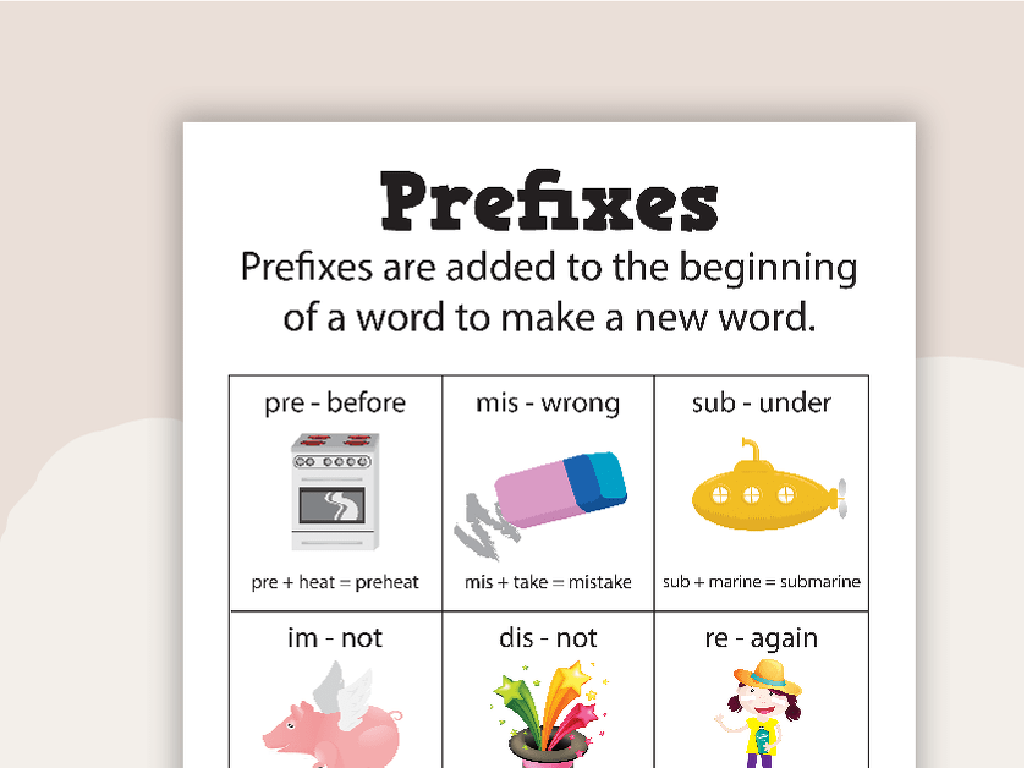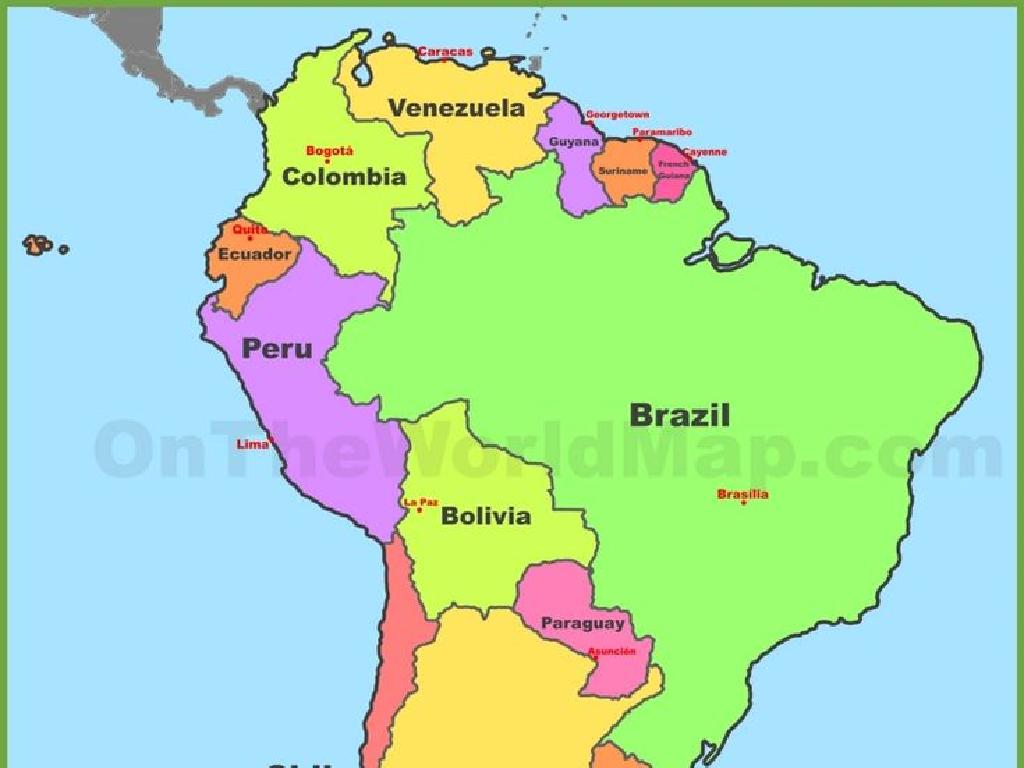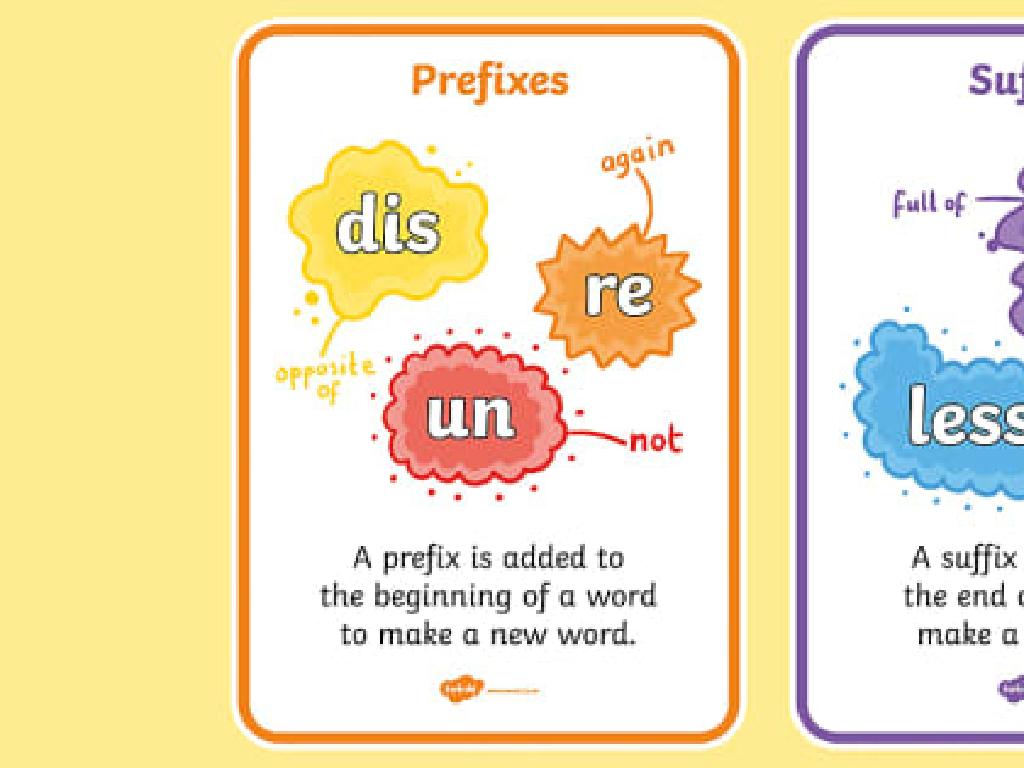Convert Decimals To Fractions And Mixed Numbers
Subject: Math
Grade: Fourth grade
Topic: Relate Fractions And Decimals
Please LOG IN to download the presentation. Access is available to registered users only.
View More Content
Converting Decimals to Fractions & Mixed Numbers
– Understand fractions & decimals
– Fractions show parts of a whole; decimals show parts of one.
– Relation between fractions & decimals
– Every decimal has a fraction equivalent, e.g., 0.75 = 3/4.
– Today’s goal: conversion skills
– We’ll learn to change decimals like 0.5 into fractions like 1/2.
– Practice with examples
– Convert 1.25 to a mixed number: 1 whole and 1/4.
|
Begin with a review of what fractions and decimals represent, emphasizing their use in everyday life. Explain that decimals and fractions are two ways of expressing the same idea: parts of a whole. Today’s lesson will focus on converting decimals to fractions and mixed numbers, a key skill in understanding and applying mathematical concepts. Provide step-by-step examples, starting with simple decimals and progressing to more complex ones, including those that convert to mixed numbers. Encourage students to think of decimals as money to help them grasp the concept of fractions and mixed numbers. Prepare interactive activities where students can practice conversions and share their methods.
Understanding Decimals
– Decimals represent parts of a whole
– Decimals are fractions with denominator 10
– Think of a dollar divided into 10 dimes
– Example: 0.5 equals 1/2
– Half a dollar is 5 dimes, so 0.5 is like 5/10
– Example: 0.75 equals 3/4
– 75 cents is 7 dimes and a nickel, so 0.75 is like 75/100
|
This slide introduces the concept of decimals to fourth-grade students. Begin by explaining that decimals are another way to represent parts of a whole, similar to fractions. Emphasize that the base-10 number system makes it easy to convert between decimals and fractions. Use everyday examples like money to illustrate this point, as children are familiar with dimes and cents. Show how 0.5 can be seen as half of a dollar or 5 out of 10 dimes, which is the same as the fraction 1/2. Similarly, demonstrate that 0.75 is three-quarters of a dollar or 75 out of 100 cents, equivalent to the fraction 3/4. Encourage students to think of other examples of decimals and how they might convert them to fractions.
Understanding Fractions
– A fraction represents part of a whole
– Like a slice of pizza is a part of a whole pizza
– Numerator and denominator explained
– Top number (numerator) shows how many parts we have. Bottom number (denominator) shows how many equal parts the whole is divided into.
– Examples: 1/2, 3/4, 2/5
– 1/2 is one out of two parts, 3/4 is three out of four parts, 2/5 is two out of five parts
|
This slide introduces the concept of fractions to fourth-grade students. Begin by explaining that a fraction is a way to represent a part of a whole, similar to how a slice of pizza is just a part of the entire pizza. Clarify the roles of the numerator and the denominator in a fraction. The numerator, the top number, indicates how many parts we are considering, while the denominator, the bottom number, shows into how many equal parts the whole is divided. Provide simple, relatable examples such as 1/2, 3/4, and 2/5 to illustrate common fractions. Encourage students to think of other examples of fractions they encounter in everyday life.
Converting Decimals to Fractions
– Every decimal equals a fraction
– Count decimal places
– If a decimal has two places, that’s the hundredths place
– Write over number with zeros
– For 0.25, write 25 over 100 because there are two decimal places
– Simplify the fraction
– Reduce 25/100 to 1/4 by dividing both numerator and denominator by 25
|
This slide is aimed at teaching fourth graders how to convert decimals to fractions. Start by explaining that every decimal number can be expressed as a fraction. To convert, they need to count how many places are after the decimal point. This tells them the place value of the last digit (tenths, hundredths, thousandths, etc.). Then, they write the decimal number without the decimal point over 1 followed by as many zeros as there are decimal places. Lastly, they should simplify the fraction by dividing the numerator and the denominator by the greatest common factor. Use examples like 0.25 becoming 25/100 and then simplifying to 1/4 to illustrate the process.
Converting Simple Decimals to Fractions
– Example: Convert 0.5 to a fraction
– Place the decimal over 10
– Since 0.5 has one decimal place, it’s 5/10
– Simplify the fraction 5/10
– Divide both numerator and denominator by 5
– Final fraction: 1/2
– Simplifying 5/10 gives us 1/2
|
This slide introduces students to the concept of converting decimals to fractions. Start with the example of 0.5, which is a simple decimal. Explain that the number of decimal places determines the denominator. For 0.5, we have one decimal place, so we use 10 as the denominator, making it 5/10. Then, guide students through the process of simplifying fractions by finding the greatest common divisor, which in this case is 5. Dividing both the numerator and denominator by 5 simplifies the fraction to 1/2. Encourage students to practice with more examples and to always simplify their fractions.
Converting Complex Decimals to Fractions
– Example: Convert 0.75 to a fraction
– Place 75 over 100 for two decimal places
– Since 0.75 has two numbers after the decimal, we use 100 as the denominator.
– Simplify 75/100 to lowest terms
– Find the greatest common divisor of 75 and 100, which is 25.
– Final fraction: 3/4
– Divide both numerator and denominator by 25 to simplify.
|
This slide aims to teach students how to convert decimals with two decimal places into fractions. Start by explaining that the number of decimal places determines the denominator: two decimal places means the denominator is 100. Then, show how to simplify the fraction by finding the greatest common divisor and dividing both the numerator and denominator by this number. Use 0.75 as an example to demonstrate the process step by step. Encourage students to practice with other decimals and to always simplify their fractions to the lowest terms.
Converting Decimals to Mixed Numbers
– Understand mixed numbers
– A mixed number includes a whole number plus a fraction
– Separate whole numbers and decimals
– Split the number at the decimal point
– Convert decimal to fraction
– Use place value to turn the decimal into a fraction
– Combine whole number and fraction
– Add the fraction to the whole number to finish
|
This slide is aimed at teaching fourth graders how to convert decimals into mixed numbers. Begin by explaining what a mixed number is, emphasizing that it consists of a whole number and a fraction. Demonstrate how to separate the whole number from the decimal part of a number. Then, guide students through the process of converting the decimal into a fraction, making sure they understand place values (tenths, hundredths, etc.). Finally, show them how to combine the whole number with the newly converted fraction to form a mixed number. Provide examples and practice problems to reinforce the concept.
Converting Decimals to Mixed Numbers
– Start with decimal 1.25
– Identify the whole number: 1
– Convert decimal to fraction: .25
– .25 equals 25/100, which simplifies to 1/4
– Combine for mixed number: 1 1/4
– The mixed number is 1 whole and 1/4
|
This slide is aimed at teaching students how to convert decimals to mixed numbers. Begin by presenting the example 1.25. Explain that the number to the left of the decimal point is the whole number. In this case, it’s 1. The numbers to the right of the decimal represent the fractional part. Teach them to convert the decimal .25 into a fraction by understanding that it is 25 out of 100, which simplifies to 1/4. Finally, show them how to combine the whole number with the fraction to form a mixed number, resulting in 1 1/4. Encourage students to practice with additional examples and ensure they understand each step of the process.
Practice Time: Converting Decimals to Fractions
– Convert 0.3 to a fraction
– 0.3 equals 3/10
– Convert 0.6 to a fraction
– 0.6 equals 6/10, which simplifies to 3/5
– Convert 0.9 to a fraction
– 0.9 equals 9/10
– Simplify the fractions
|
This slide is designed for a practice activity where students will apply their knowledge of converting decimals to fractions. Start by demonstrating how to convert a decimal to a fraction by placing the decimal number over its place value (e.g., 0.3 over 10 because it’s in the tenths place). Then, guide students to convert 0.6 and 0.9 to fractions. Emphasize the importance of simplifying fractions to their lowest terms, such as reducing 6/10 to 3/5. Encourage students to work through these examples and check their understanding by simplifying the fractions. Provide additional examples if time allows and ensure to assist any students who may need extra help with the concept.
Class Activity: Fraction & Decimal Conversion
– Convert 0.4 to a fraction
– Remember, 0.4 means 4 tenths
– Turn 1.08 into a mixed number
– 1.08 means 1 whole and 8 hundredths
– Change 2.35 to a mixed number
– 2.35 means 2 wholes and 35 hundredths
– Discuss and solve in pairs
|
This activity is designed to help students practice converting decimals to fractions and mixed numbers. Start by explaining that the place value of the decimal determines the denominator of the fraction. For example, 0.4 is 4 tenths, so it converts to 4/10. For mixed numbers like 1.08, students should recognize 1 as the whole number and 0.08 as 8 hundredths, making it 1 and 8/100. Encourage students to work in pairs to foster collaborative learning and problem-solving skills. After the activity, review the answers as a class to ensure understanding and correct any misconceptions. Possible variations for different pairs could include converting decimals such as 0.75, 3.06, or 0.52 to keep the activity dynamic and engaging.
Wrapping Up: Decimals to Fractions!
– Congratulations on learning conversions!
– Homework: Practice worksheet
– Complete the provided problems to reinforce today’s lesson
– Bring questions to the next class
– Don’t hesitate to ask for help with tricky problems
– Keep practicing at home!
|
This slide marks the conclusion of the lesson on converting decimals to fractions and mixed numbers. The students are assigned a worksheet for homework to further practice the concepts learned in class. It’s important to encourage them to attempt all the problems and to remind them that it’s okay to have questions – these should be brought to the next class for clarification. The aim is to reinforce their understanding through practice and to ensure they feel supported throughout their learning process. As a teacher, be prepared to address common issues students may encounter and to offer additional examples or strategies during the next session.

/early_republic_us_history.jpg)




